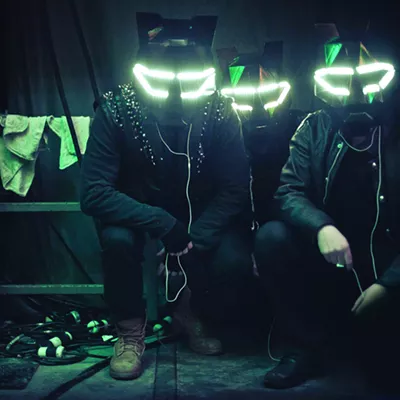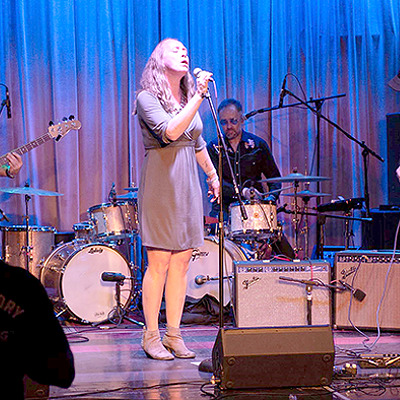"It's the first dance performance at the Fox since about 1956," calculates Herb Stratford, executive director of the Fox, who deserves extraordinary credit for the rehab and recent re-opening of the grand old movie palace.
The Fox primarily screened movies from 1930 to 1974, when it closed, but live vaudeville acts appeared sporadically, Stratford says, including the dancing Griffiths of the 1930s and '40s.
Flying and Films at the Fox, the O-T-O concerts playing this Thursday and Saturday, pay homage to that lively theatrical history. The unusual program features screenings of three avant-garde dance movies by New York filmmaker Jodi Kaplan, spliced between dance works performed live onstage by the O-T-O'ers. Odaiko Sonora also contributes live music, in the form of giant Japanese Taiko drums.
O-T-O has been itching to get into the exquisitely renovated theatre, which boasts Southwest art-deco décor, including a teal-and-orange starburst painting that covers the entire ceiling.
"It's a beautiful facility," says Chuck Koesters, technical director of O-T-O. "I did a walk-through with Herb when it was still a derelict building. Now it takes your breath away. I can't wait to put lights on the stage."
The Fox, rehabbed with Rio Nuevo money, private and corporate donations and an 11th-hour loan from the city, re-opened New Year's Eve. Its new state-of-the-art tech equipment will get a good workout with the O-T-O show. Kaplan will see her movies on the big screen, and Koesters will project his videos onto the stage backdrop and hear his recorded music on the new sound system. The dancers will fly on their trademark trapezes over the stage, and come back down to dance atop a Marley dance floor they'll lug in from their studio.
"Hawaiian Suite," a collaboration between Koesters and his wife, O-T-O artistic director Annie Bunker, meshes live dance, a video backdrop and original music. Inspired by the couple's sojourns in the islands in recent years, "Suite" gets its full premiere at the Fox. (The troupe has offered sneak previews of some segments in the last year.)
Bunker says she adapted her choreography to fit the dancing into the relatively shallow stage of the Fox, just 34 feet deep and 40 feet wide. For instance, "Pahoehoe Dreams," the first section of the four-part Hawaiian work, originally had four trapezes, and for these concerts, she's cut them down to two.
"I measured the stage at the Fox and then taped its dimensions on the floor back in the studio," Bunker reports.
Koesters' videos capture lava shooting out over the ocean at night, and other Hawaiian wonders such as orchids and hibiscus. One video records sunlight rippling underneath the waves; like one of Kaplan's movies, it was shot underwater. The all-female cast ("Hawaii is very female," Bunker says) includes Lena Lauer, Sukie Keita, Nicole Sasala, Danielle Jones and Nicole Stansbury. Bunker herself performs a solo in front of the moving lava. Most of the music is Koesters', but one section, "Pele's Breath," is danced to a composition by R. Carlos Nakai and Keola Beamer.
Filmmaker Kaplan has not yet been to Tucson--she's coming to town for the concert--but she says "it's an honor" to have her works screened in the venerable theater. "I've heard it's so great."
The show's format, she says by telephone from New York, will be "dance-film-dance-film." The setup is a first for her. "I have never screened my work with another artist's, especially dance. It's a risk for me. I don't know how it will play, but I'm excited about it."
She'll show three relatively short dance films, each with a distinctive setting: underneath a trampoline, underwater and, more conventionally for dance, in front of a mirror. Educated at Smith College and Columbia University, Kaplan has no interest in running a regular dance troupe, she says, but she choreographs the movement in her own movies.
The three films all explore liminal states, the shadowy border between life and death, between past and present. Wall, commissioned by the Poetry Society of New York, is "based on an interpretation of a poem by Gabriela Mistral, an incredible poet from Chile." The poem recounts Mistral's grief at the suicide of her friend, who may have also been her lover.
"I shot it underneath a trampoline--that's a mesh between this world and the next," Kaplan says.
Curiously, she used three men in the piece, two dancers and a champion diver, Scott Donie, who won an Olympic medal in the Barcelona games.
"I tend to use all men or all women," she says, but she brought in a female singer to chant the musical works of medieval mystic Hildegard von Bingen.
Chorea poses two dancers against mirrors, creating multiple images. The two women look alike, Kaplan notes, and loosely represent one woman's past and future selves. Shot in black and white, "It's about time, the past, present and future merging together."
Immersion is "very special to me," Kaplan says; she made it after witnessing the cancer death of a close friend.
"It's shot entirely underwater. It's beautiful, a dance film that captures the spirit passing in the moment before death."
Featuring three female dancers underwater, the film was shot in the Columbia pool, but canvas backdrops erased the functional concrete and transformed it into "the other world." This underwater work will appear immediately before the ocean-rich "Hawaiian Suite."
Among the flesh-and-blood danceworks on the program is the Japanese-inspired "Wa-Ei Dansu," a Bunker collaboration with Odaiko Sonora that premiered in November.
"We edited out a few of the drums because of the size of the stage," Bunker explains. "The piece has to do with calligraphy and motion, linear motion."
Sometimes the O-T-O dancers dance, and sometimes they drum along with the quartet of drummers, who include Odaiko founders Karen Falkenstrom and Rome Hamner. Charles Thompson, a former O-T-O dancer who now lives in California, returns to dance a solo.
Dancer Stansbury debuts a piece of her own choreography, "Wide Eyes," a humorous work for five. Local musician Chris Levesque contributed an original score.
Thom Lewis, co-director of FUNHOUSE movement theater and a co-director of the now-defunct 10th Street Danceworks, helped found Orts Theater of Dance 21 years ago. (Orts evolved into O-T-O a couple of years back.) He's selected a piece whose title, "Everlast," is marvelously apropros for a theater that's just reopened after being dark for 32 years.
In his duet, he and Bunker portray the ups and downs of a longtime couple so contentious they've outfitted themselves in red boxing gloves. An old Tucson favorite, the dance is set to the music of Lyle Lovett.
The marriage the dance portrays is destined for the ash heap, but the theater that will host it, almost miraculously, is not. Instead of falling to the wrecking ball, as so many historic Tucson buildings have done, it's been born into a second life, becoming, as Koesters puts it, "a treasure for the community."














